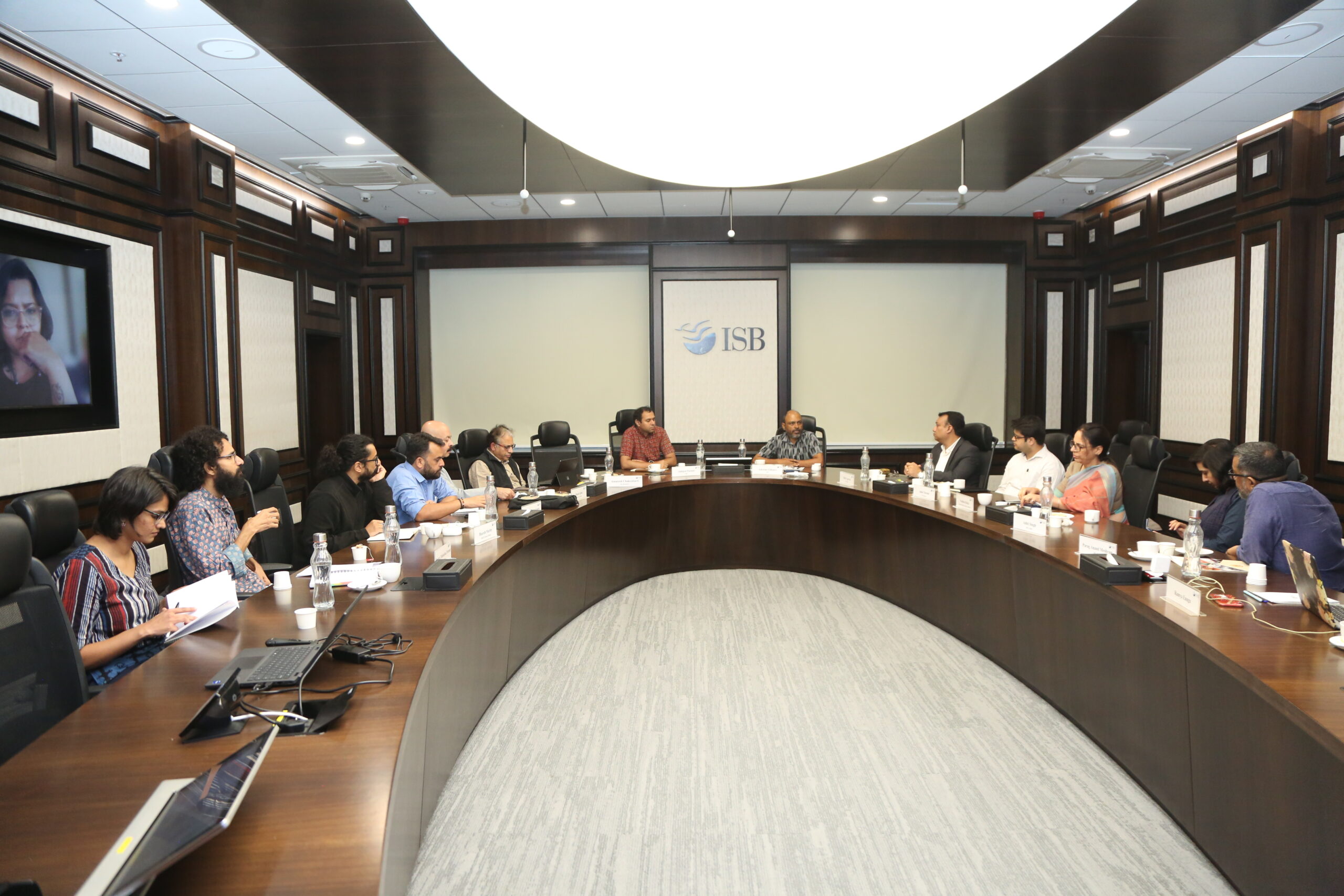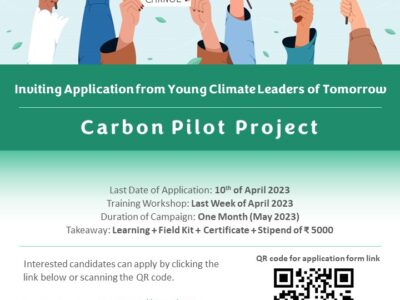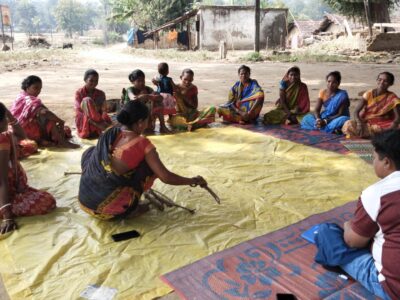Roundtable Series: “Design and Communication for Sustainable Forest Economy”

“Design and Communication for Sustainable Forest Economy” was the topic of the third of four roundtables (RTs) held in November 2022 to move further towards the vision of “Initiative on the Forest Economy (IoFE)” by the Bharti Institute of Public Policy’s (BIPP), Indian School of Business (ISB).
Designers, artists, and representatives from civil society came together for this closed group discussion. Prof. Ashwini Chhatre, Director, BIPP-ISB, shared the vision for a thriving forest economy and the potential that the forest economy model, anchored in secure tenure, holds for the industry, the macro economy, the communities, and the sustainable management of forest resources. He opened the discussion by speaking about building a robust design to facilitate the dissemination of information. ” He believes that reducing information asymmetry among key stakeholders is essential for this model to work. It is necessary to make sure that everyone can make an informed choice. Understanding the wide range of stakeholders playing a variety of roles at different levels is key to the forest economy model. Accessibility to information will also enhance communication among stakeholders, such as communities, government agencies, the commercial sector, technology developers, and suppliers. There are several public and private schemes and regulations that can allow opportunities for strengthening the role and position of women in the value chain.
Representatives from the Indian Institute of Technology (IIT) Kanpur’s Incubation division discussed the institute’s current work in the Technology for Tribal programme. He shared his experience with setting up a jamun pulp production unit. The processes of handpicking jamun, processing it, and bottling jamun pulp were streamlined. Their interventions reduced waste by up to 50%. They highlighted how those tribal systems could offer an indigenous design element to provide robustness to modern technology while advances in bioscience can support the management of forest products. There is a huge information gap, which calls for additional effort as well as cooperation between different public and private entities. Empowering the tribals requires simple, uncomplicated solutions and the government’s support for the effective implementation of such institutional initiatives. They highlighted the financial challenges faced during the delivery of outcomes that came out of the hackathon organised to address forest product-related problems. In conclusion, they discussed the need for a business process framework that is adaptable to many situations and circumstances.
The representatives from the School of Planning and Architecture (SPA), Delhi, discussed aspects of deploying prototype business models and the associated logistical support and cost-effective technology. They resonated with the provisioning of simple solutions designed using conventional technology. He provided an example of his students working on developing an incubator. It was important to understand the basic features of an incubator and consider its utility in areas where electricity is scarce. They devised a solar-powered incubator that was a robust design solution for the given criteria. Such simple solutions can help in designing technology for tribals.
The importance of creating awareness about forest-based products was discussed. This attitude shift can create demand at scale, driving large companies to accept such a sustainable business model in the long run. The representatives from the Industrial Design Centre, IIT Bombay, Echo Network, and Srishti Institute of Art, Design, and Technology each made recommendations based on their experience with storytelling tools to enhance women’s engagement. Raising awareness through effective communication and activities such as puppetry, plays, comics, filmmaking, and other documenting methods for putting the spotlight on seasonal forest products were a few other strategies proposed to facilitate working with forest-dependent communities. The need for empathetic listening and acknowledging the needs of the communities are key to designing a supportive economic model for them It was highlighted that each community has its own priorities and systems that can enrich the model with knowledge and stewardship if the youth are trained with an understanding of cultural and socio-ecological nuance.
Principal ideas of the discussion:
Institutional tie-ups between IIT, ISB, and the National Institute of Design (NID) to contribute to respective domain areas of machine design, business mentorship, strategy, filmmaking, and communication. BIPP-ISB’s role will be to strengthen financial accessibility and the policy framework.
The stakeholders shall design a strategy to strengthen seasonal forest product market connections. Pick a regional product that is ecologically viable, do a trial project to improve the product, and then expand across other regions of India. Incorporate communication, political, and economic factors during the business framework design process. Discover strategies to expand access to healthcare, education, and income for forest-based communities with the assistance of initiatives such as Pradhan Mantri Van Dhan Yojana’s Entrepreneurship and Skill Development Programme (PMVDY-ESDP) without compromising the tribal groups’ cultural and ethnic identity. Using a variety of communication channels to overcome cultural and linguistic barriers and build trust Guarantee creative dignity and visibility while working with tribal groups to increase income through the implementation of appropriate governance mechanisms to manage and support agreements. Provide an autonomous business framework for the value chain enabler to depart.
Prof. Ashwini Chhatre suggested the need to establish an ecosystem in which communities get access to societal benefits like education, wages that reflect the dignity of labour, insurance, and social security. An ecosystem where individuals with an entrepreneurial spirit find opportunities and support to accomplish their aspirations. The first stage, according to him, is to identify existing value chains that are unjust to women and legally organise them in a manner that permits higher value capture in local marketplaces. He discussed the concept of empowering communities until local leadership emerges and an action plan is established, while experimenting with an environment that enables local communities to think. He spoke at length to address a few challenges surrounding how to generate enthusiasm for constructing and operating a formal business model across all value chain participants. He described the scale for formal sales and how we can expand capacity by entering the value chain at the beginning stages, as well as how we can improve the direct sale of seasonal forest products to industries by forming long-term partnerships. He underlined that we are creating opportunities and space for constructing a forest economy based on forest products.
He continued by highlighting the future opportunities for developing new models to access community-beneficial profit-sharing and licencing regimes. By reinvesting in the natural system for regeneration and leveraging the existing legal framework, we can partake in the progress of the community. He foresaw the advantages of capturing the biodiversity register’s traditional knowledge and cultural features, which will, in turn, create prospects for future innovations and new models of solutions.
Development initiatives like the proposed forest economy model involve communication: communication between members of a community, communication between community members and government stakeholders, communication between corporate and community members, and so on. Information, along with hope, fear, and other emotions, is also exchanged. Designing this amalgamation is important to communicate the true intent of the initiative. Participants discussed experiences from the field, classroom, and projects. Design thinking as a framework to enable development communication was discussed at length. The RT discussion highlighted how the design-centric framework can be effective in developing communication and process frameworks capable of triggering intended change.
Roundtable delegates:
- Aditi Singh, Professor, DOID, School of Planning and Architecture, Delhi
- Ankit Saxena, AVP, SIIC, Indian Institute of Technology, Kanpur
- Bharat Chhitubhai Parmar, Professor, Industrial Design Centre, IIT Bombay
- Bharath Murthy, Professor, SRISTI School of Design, Manipal Academy, Bangalore
- Danish Iqbal, Dean and Course Director, AJK Mass Communication Research Centre, Delhi
- Digangana, Head of Communications, The Echo Network
- Mukesh Kumar Gupta, Head, Livelihood Program, Barefoot College, Tilonia, Rajasthan
- Neelima Hasija, Head, Integrated Design Service, National Institute of Design, Ahmedabad
- Nikhil Agarwal, CEO, SIIC, Indian Institute of Technology, Kanpur
- Parag Anand Meshram Head, DOID, School of Planning and Architecture, Delhi



